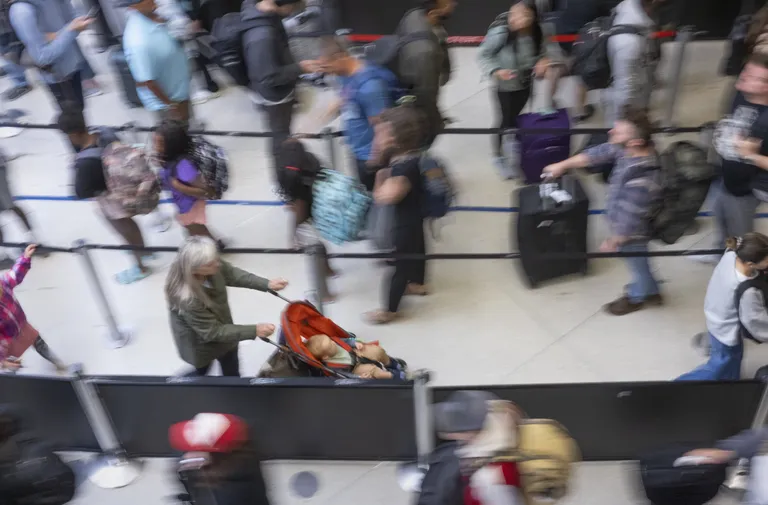If it feels like flying out of Seattle is more arduous than ever lately, you’re not alone — with the highs of summer come the lows of travel.
This summer, the average wait times in security lines at the Seattle-Tacoma International Airport during peak travel hours are longer than they were before the COVID-19 pandemic.
While passenger traffic this year is still lower than in 2019, Sea-Tac recorded its busiest day in airport history Monday, in part thanks to Taylor Swift fans heading home after concerts last weekend.
Travelers passing through Sea-Tac at peak times this June and July spent about half an hour getting through security, according to data from the Port of Seattle provided to The Seattle Times. In 2019, before the pandemic-led air travel crash, the peak average wait time was 20 minutes.
Peak hours at Sea-Tac run from 4 a.m. to 2 p.m., with the most traffic between 5 a.m. and 12 p.m.
Aside from the average, the maximum wait time passengers spent in line for a security check at any point in June was over an hour and a half. That’s the longest wait time recorded since weather-related delays caused maximum wait times to hit new highs in November and December.
Wait times are usually far below those maximums throughout the day. Still, it’s a palpable increase from a max of 35 minutes in January.
On the whole, fewer travelers are waiting less than 20 minutes at Sea-Tac’s security checkpoints this year. For the first time in four years, less than 80% of travelers spent less than half an hour going through security. Less than half spent less than 20 minutes.
Sea-Tac has the sixth-longest wait times among all airports in the country, according to a study on airport wait times by luggage storage company Bounce released in June.
For those looking to avoid high wait times, consider booking flights outside the peak hours of 4 a.m. to 2 p.m. If that’s not possible, consider using TSA Precheck or Clear, or planning ahead with SEA Spot Saver, the Port’s free appointment system for security screenings.
So, does the growth in wait times since their pandemic lows mean air travel has bounced back? Not quite, Sea-Tac Airport spokesperson Perry Cooper said.
Passenger volumes are rising with a record cruise season this year, but traffic is still lighter than in 2019, when the airport recorded its busiest year ever.
“If you and I walk in through there, we’re not going to notice the difference, but we’re still down 5% to 6% from 2019, or 1% to 2% right now in the summer,” Cooper said.
From June to mid-July, the average number of passengers screened each day by the Transportation Security Administration was about 63,000; in 2019 it was about 64,000. The Port of Seattle, which operates the airport, projects a full return to 2019 levels in 2024.
As numbers rise, so will the challenges that come with Sea-Tac’s small footprint, which doesn’t allow for adding new security checkpoints.
Even with all checkpoints and lanes open, the airport can only push through so many passengers an hour. As airlines accommodate more passengers by adding larger aircraft to their fleets, more passengers can fly during the morning peak hours. Yet only so many can fit through, and backups have a domino effect.
“All our checkpoints lead to all gates, and that’s how we’re a little bit different from other airports,” Cooper said. “On the one hand, it’s convenient but on the other, without multiple terminals, we can’t separate folks to other areas.
“We just don’t have the space.”
On Monday, after over 140,000 Taylor Swift fans broke a Lumen Field attendance record last weekend, Sea-Tac recorded its busiest day in airport history. With a volume of 73,651 passengers, the day eclipsed the previous high of 72,154 recorded in August 2019. Yet, wait times did not peak.
“Quite honestly, we didn’t see big wait times at all on Monday, even though we had a record day,” Perry said.
Apart from passenger volumes, a major factor affecting wait times is staffing for shuttle buses, airline check-ins and security lanes. Technical problems with screening equipment, although less common, also create delays.
“The airport is not immune to the staffing shortages we’re facing across the country,” Cooper said. “Ideally, we want to have all of our lanes open during the peak periods and from a scheduling standpoint, that’s what TSA and all of us here at the airport are trying to manage.”
The number of open lanes to each of the Port’s five security checkpoints heavily depends on TSA staffing, which has faced a crunch since the pandemic. While TSA has added more staffers for Sea-Tac, the Port says it still needs more.
Visual reporting of local news and trends is partially underwritten by Microsoft Philanthropies. The Seattle Times maintains editorial control over this and all its coverage.
